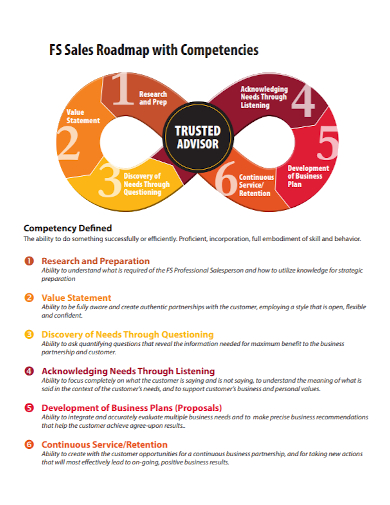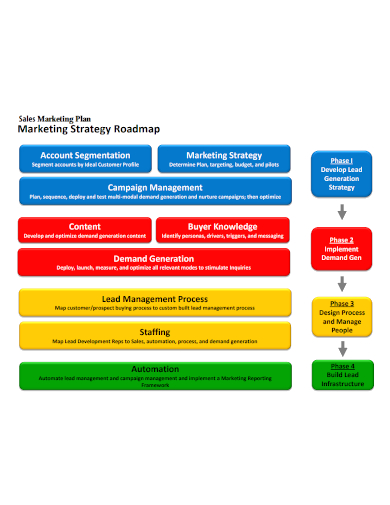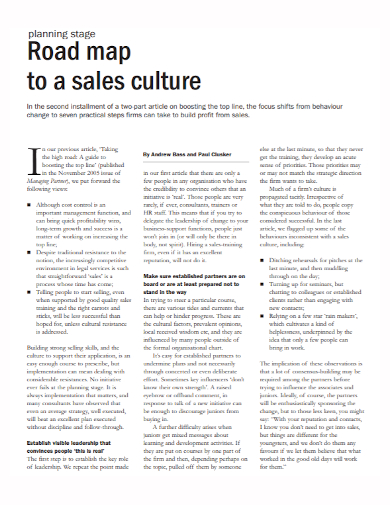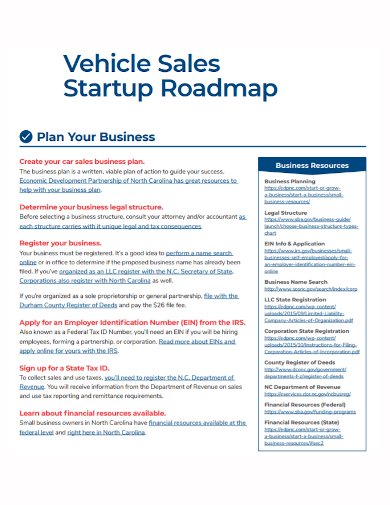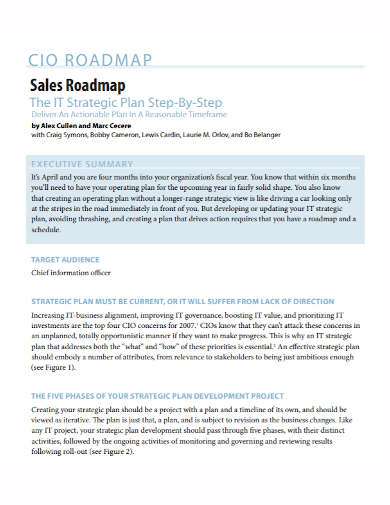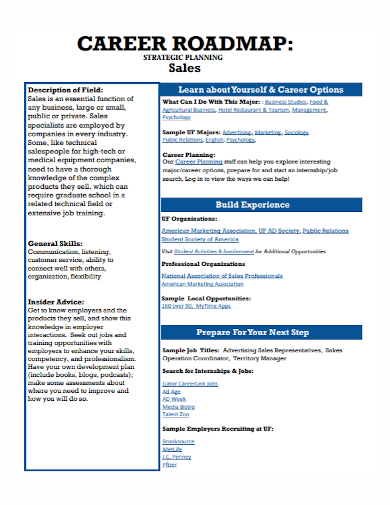Having a solid sales plan in place is the first step in getting off on the right foot in a new fiscal year. Owners and Sales Leaders must develop a company-level strategic sales plan to provide direction for the individual sales plans managed by their salespeople, rather than relying on their salespeople to instinctively know the best course of action. Salespeople can help maximize ROI on planning time by incorporating aligned action plans that take into account customer events, product launches, promotion activities, and other factors by providing this information. Your team will be able to deliver results by staying on track with both company-level and individual sales plans in place. While working toward their own personal objectives, salespeople can keep the big picture in mind.
5+ Sales Plan Roadmap Samples
A sales roadmap, also referred to as a sales plan, is a high-level overview of your company’s overall sales trajectory. It usually includes sales objectives, key deals, and key tactics that your sales team will pursue in order to expand the company. Sales roadmaps, which evolved from product roadmaps, are living documents. The sales roadmap will need to change as your product offering evolves and your company expands.
1. Sales Plan Competency Roadmap
2. Sales Marketing Plan Roadmap
3. Sample Sales Plan Roadmap
4. Business Sales Plan Roadmap
5. IT Sales Plan Roadmap
6. Career Sales Plan Roadmap
Steps in Creating a Sales Plan Roadmap
- Define your sales goals and milestones – First and foremost, you must understand the direction in which your sales team is heading. Define your overall revenue and sales goals for the year using past sales data and any other relevant information. Choose KPIs that will help you understand your objectives. Setting quarterly goals or milestones can help you keep track of your progress throughout the year. You can also set goals for yourself, such as closing a certain number of deals or signing a high-profile client, or anything else that will help you advance your sales strategy.
- Identify high-impact deals – Deals with high revenue or visibility can have a significant impact on your overall sales strategy, so it’s critical to understand how they’ll do so. These types of deals can take months to finalize, so knowing when you can expect them to close has a big impact on meeting your sales targets. It’s a good idea to identify the salespeople in charge of high-impact deals so that you can check in with them as the sales manager if something unexpected happens.
- Outline your sales pipeline – Now is the time to create a sales pipeline if you don’t already have one. A sales pipeline identifies all of the touchpoints that a potential client will encounter before deciding to do business with you. Prospecting, cold or warm emailing or calling, and sales meetings are examples of tasks that fall under this category. Importantly, your sales pipeline should specify how a deal can be considered closed. Normally, this entails signing a contract, but if there are any other steps to take, make sure your sales team is aware of them.
- Organize your sales roadmap – The most important thing is to convey everything we’ve discussed in this article in a clear, visual manner. To create a clear picture of where you are, where you’re going, and how you’ll get there, remove jargon and unnecessary elements.
- Share the roadmap with your sales team – Finally, inform your team about your sales strategy. They’ll be able to provide feedback and make adjustments, but it’s also critical that the sales roadmap is easily accessible so that teams stay on track. Keep in mind that as your company grows and changes, you’ll need to make changes to your sales strategy. Get feedback from your team every time so you’re on the same page.
FAQs
What are the basic elements a company-level strategic sales plan include?
- Brand Identity
- Industry Positioning
- Target Markets
- Competition
- Sales Channels
- Ideal Customer Profile
- Value Proposition and Proof Points
- Buyer and Influencer Personas
- Competitive SWOT
Who owns the roadmap intended for an enterprise?
At this point, the roadmap is almost entirely owned by your VP of Sales or CRO. And, to be honest, they’re worried about their most important transactions. Since we’re talking about businesses, your executive team is bound to be interested in this roadmap. Also, don’t overlook the product. They’ll also have a “semi-veto” on the roadmap, as your product strategy will influence your biggest transactions.
It’s fine if your sales roadmap goes through several iterations; it’s there to help you and your sales team grow. You’ll be well on your way to closing more deals if you set clear goals, define how you’ll achieve them, and share that information with your team.
Allow your sales roadmap to grow and change as your company does. This adaptability allows you to keep the needs of your customers at the forefront of your mind. Then you can fine-tune your sales strategies to best reach your most valuable customers.
Related Posts
FREE 10+ Startup Roadmap Samples in MS Word | MS Excel | PowerPoint | Apple Pages | Google Docs | Google Sheets | Slides | Keynote | PDF
FREE 10+ Quality Roadmap Samples in MS Word | MS Excel | PowerPoint | Apple Pages | Google Docs | Google Sheets | Slides | Keynote | PDF
FREE 10+ Timeline Roadmap Samples in MS Word | MS Excel | PowerPoint | Apple Pages | Google Docs | Google Sheets | Slides | Keynote | PDF
FREE 10+ Goals Roadmap Samples in MS Word | MS Excel | PowerPoint | Apple Pages | Google Docs | Google Sheets | Slides | Keynote | PDF
FREE 10+ HR Roadmap Samples in MS Word | MS Excel | PowerPoint | Apple Pages | Google Docs | Google Sheets | Slides | Keynote | PDF
FREE 10+ Personal Roadmap Samples in Word | Google Docs | Google Slides | Apple Keynote | PowerPoint | Apple Pages | PDF
FREE 10+ Development Roadmap Samples in Word | Google Docs | Google Sheets | Excel | Slides | Keynote | PPT | PDF
FREE 10+ Training Roadmap Samples in MS Word | Google Docs | Google Slides | Apple Keynote | PowerPoint | Apple Pages | PDF
FREE 10+ Management Roadmap Samples in Word | Google Docs | Google Sheets | Excel | Slides | Keynote | PPT | PDF
FREE 10+ Program Roadmap Samples in Word | Google Docs | Google Sheets | Excel | Slides | Keynote | PPT | Pages | PDF
FREE 10+ Project Roadmap Samples in MS Word | Google Docs | Google Slides | Google Sheets | PPT | MS Excel | Apple Pages | Apple Numbers | PDF
FREE 10+ Process Roadmap Samples in MS Word | Google Docs | Google Sheets | PPT | MS Excel | Apple Pages | Apple Numbers | PDF
FREE 10+ Strategy Roadmap Samples in MS Word | Google Docs | Google Sheets | PPT | MS Excel | Apple Pages | Apple Numbers | PDF
FREE 15+ Software Roadmap Samples in PDF
FREE 6+ Business Roadmap Samples in PDF

